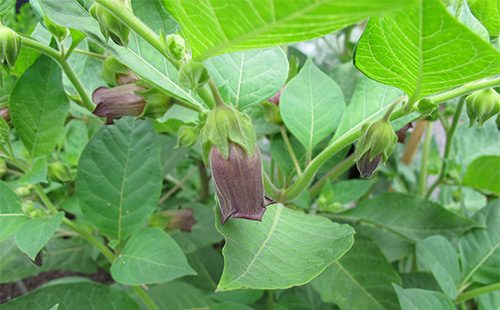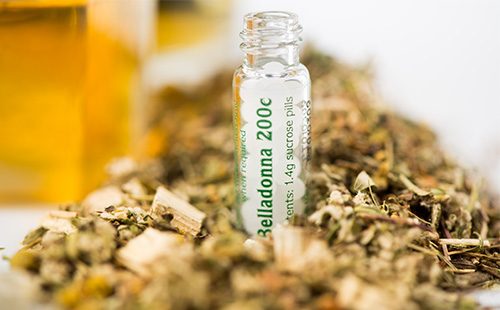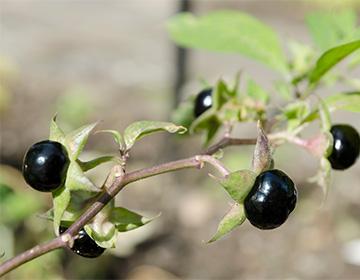The content of the article
In ancient times, belladonna was used by healers, sorcerers and witches. According to legend, it was thanks to this plant that they could fly. Also belladonna was a member of many ceremonies. External means from it plunged a person into sleep for a day or more.
Botanical characteristic
Today belladonna is specially cultivated for medical use. Plantations are in the Krasnodar and Voronezh regions. Culture is also cultivated in the southern regions of Ukraine. Wild belladonna is extremely rare. Mostly in mountainous and foothill areas - in the Caucasus, Transcaucasia, in the Carpathians, Crimea.
It prefers fertile soils rich in humus. It is found in oak, hornbeam groves, beech forests. Often chooses lighted places - clearings, edges, undergrowth. On moist soils near reservoirs it grows well, forming thickets. Wild grass is harvested by traditional healers. You can recognize the plant by morphological characteristics.
- Underground part. It is represented by a fleshy and juicy many-headed rhizome, which grows from a core root. Multiple spindle-shaped roots grow from the rhizome deep into the soil.
- The stalks. Cylindrical stems can have a green or brown-purple color. Grow fast. Under favorable conditions, in height reach about 2 m. Leafy. Starting from the upper half, branch three times. Each branch is divided into a “fork” or forms a false whorl.
- Leaves. The bare petioles are located alternately in the lower part of the stem. Sheet plates have a solid edge. They are elongated, elliptical in shape, with a pointed end. Color - deep green. Covered with small glands, due to which they exude a pronounced aroma. Above are arranged in pairs. In the pair there is one full leaf (large), the second one is much smaller in size and obovate. Sheets reach 11 cm in length and 7.5 cm in width.
- Flowers. Belladonna blooms in June. Flowers of the correct form, five-petalled, have a double perianth. The shape is bell-shaped. Located singly in the axils of the leaves. Color - white-brown-purple. The aroma is stupefying.
- Fruit. Multi-seeded berries form since August. By the size of the hearths, belladonna is close to cherry. Green fruits are covered with dark glands. When ripe, they become saturated purple, almost black. Their surface is shiny, glossy.
Harvesting raw materials
They have been preparing for harvesting since June. At this time, pharmacopoeial medicinal raw materials are collected - leaves.
- Collection. Large and well-developed leaves are torn from the stems manually. Break off only the lower part, before branching. Upper - harvested at the end of flowering.
- Training. Sort the raw materials for dried, discolored, damaged leaf plates.
- Drying. Dried quickly using a dryer. The raw materials are laid out in a thin layer. Temperature condition - 40ºС.
The second type of raw material is belladonna grass. Used to produce the atropine alkaloid and the preparation of galenic dosage forms from a plant.
- Collection. The grass is mowed at the time the fruit is formed. Do this with sickles or hand braids, retreating from the soil about 10 cm.
- Training. Stems are sorted, thrown out spoiled. Scissors chop them into pieces up to 4 cm long.
- Drying. The raw materials are dried in dryers, observing a reduced temperature regime. In the process, juicy stems are often tedious.
Roots are also used to make medicines. They are dug up after the death of the aboveground part. Washed from the ground, crushed into pieces up to 20 cm long. If the rhizomes are too thick - split into parts. It is also dried at low temperatures or in natural conditions, having previously dried.

Composition
The main pharmacologically active component is considered to be the atropine alkaloid. It was because of him that the plant began to be cultivated - the substance is actively used in the pharmaceutical industry in many countries. Atropine refers to M-anticholinergic. His actions:
- relaxes smooth muscles;
- reduces the activity of endocrine glands;
- stimulates the respiratory center;
- increases contractile function of the myocardium.
Due to the ability to dilate the pupil, it is often used in ophthalmology for a thorough study of the condition of the fundus.
However, belladonna also contains other alkaloids. This is due to the extensive list of folk indications for the use of the plant. The composition includes:
- scopolamine;
- hyoscine;
- hyoscyamine;
- apoatropin;
- belladonin;
- kuskgigrin.
The highest concentrations of alkaloids are noted in the composition of the plant roots - up to 4%. In leaves and stems - up to 1.2% and up to 0.9%, respectively. As part of the fruits -
less than 1%, but their toxicity is due to toxins from other groups of chemicals.
As a medicinal plant material, leaves are often used. In addition to alkaloids, they are rich in volatile compounds, flavonoids, organic acids.
Due to its complex composition, the culture exhibits such pharmacological effects:
- antispasmodic;
- tonic;
- expectorant;
- anti-asthmatic;
- anesthetic;
- hyposecretory;
- cardioprotective.
Diseases for which it helps
Even experienced phytotherapists treat the culture with caution - they carefully select the dose, observe the technique for preparing medicines. Traditional healers resort to the help of the belladonna only as a last resort. The reasons for using grass may be the following conditions.
- Malignant lesions of the body. It is believed that the external use of grass leaves in powdered form helps to get rid of tumors in the mammary glands, eliminate ulcers of the skin. Inside, belladonna is recommended for a variety of localizations of oncology - from lesions of the esophagus to ovarian cancer.
- Parkinson's disease. As a medicine, herbalists recommend taking a decoction.After a few days, the tool reduces the severity of tremor and the inconvenience associated with it, normalizes sleep and improves the patient's psycho-emotional state.
- Joint pain. Rubbing and compresses help to alleviate the discomfort of arthritis, arthrosis, gout, dislocations, bruises, closed fractures, radiculitis, myositis. Plant rubbing and compresses with hoods are considered equally effective.
- Diseases of the prostate. The practice of treating prostatitis with belladonna candles has no scientific justification, but herbalists and traditional healers still recommend the remedy. Doctors say that the anti-inflammatory and antibacterial properties of belladonna are not active enough to reduce symptoms or eliminate the causes of the disease.
In traditional medicine, the scope of application of funds is also numerous. Belladonna preparations are prescribed in the following cases.
- Airway cramps. Alkaloids eliminate laryngo-and bronchospasm. Aerosol dosage forms are prepared from the plant.
- Gastrointestinal spasms. Painful cramps often occur on the background of enterocolitis, peptic ulcer, gastritis. In this case, the grass not only relieves bouts of colic, but also suppresses the excessive secretion of glands. Suppositories eliminate spasms of the sphincter of the rectum with hemorrhoids, which relieves pain.
- Cardiodiagnoses. The use of drugs from the plant is appropriate in the complex therapy of angina pectoris, bradycardia, atrioventricular block (impaired conduction of impulses in the myocardium).
- Endocrine disorders. Hyperfunctions of the glands are as dangerous as their insufficiency. Most often belladonna recommend suppressing the activity of the digestive glands and thyroid gland. In the latter case, the patient is markedly reduced sweating.
- Gynecology. Herbal remedies cope with myometrial hypertonicity. They can be used during labor stimulation to “streamline” the ratio of the phases of contraction and relaxation.
- Neurology. The effectiveness of belladonna against Parkinson's disease has been scientifically proven. Also, the plant is used for paresis, accompanying cerebral palsy, depressive mental disorders.
Given the many features of belladonna therapy, a large list of contraindications and side effects, it is forbidden to use it for medicinal purposes without the consent of a specialist. The duration of therapy and dosage should be agreed with the doctor.
Medications
Ordinary belladonna is grown on an industrial scale to produce dry and thick extracts, from which drugs are then made. Ready-made preparations based on plants are also sold.
- Pills. For example, Bekarbon and Besalol. They are used for cramping of the gastrointestinal tract, poisoning, stool disorders, pain with ulcers and gastritis. "Belloid" is also produced - a remedy for heart failure, nervousness, insomnia, endocrinological pathologies, sweating, and neurogenic cycle disorders in women.
- Tincture. Alcohol extract is used to eliminate spasms in diseases of the gastrointestinal tract. Depending on the condition of the patient, a dose of ten drops to half a teaspoon of tincture can be prescribed up to three times a day.
- Candles "Belladonna Extract" and "Anuzol" are prepared using a thick extract of the plant. Applied to eliminate the pain accompanying hemorrhoids. Sometimes prescribed by gynecologists to accelerate and facilitate childbirth - the active substance relaxes the myometrium and helps soften the cervix.
Prescribe these drugs and choose the dosage should be exclusively a doctor.

Overdose and side effects
Culture will not apply in the following cases:
- childhood;
- pregnancy and lactation;
- risk of bleeding;
- hypertension;
- tachycardia;
- increased intraocular pressure;
- intestinal atony;
- tendency to constipation;
- exhaustion;
- ulcerative colitis.
Phytotherapy has several features. Side effects are manifested by a feeling of dry mouth, constipation, dizziness, photophobia. Belladonna drugs can not be prescribed to people working with potentially dangerous mechanisms. Undesirable use in men with prostate adenoma. When treating with a plant, it should be borne in mind that it increases the risk of heat stroke in the warm season. Therefore, the patient needs to drink a sufficient amount of liquid.
With prolonged use or exceeding the recommended doses, poisoning is possible. Its severe consequences are complete respiratory depression, severe hallucinations. Symptoms
- changes in consciousness;
- increased irritability;
- nausea;
- tachycardia;
- hyperthermia;
- hives.
With any manifestations of an overdose, it is necessary to call an ambulance team. First aid is washing the stomach with plenty of water, setting cleansing enemas.
The safest dosage forms based on culture are ointments and homeopathic remedies. The latter contain extracts from grass in large breeding. Small doses of belladonna poisons have a pronounced therapeutic effect in case of ear and toothache, frequent spasms of the digestive system, and disorders of the central nervous system. The diluted Belladonna preparation is used for the preparation of homeopathic medicines with a combined composition.

